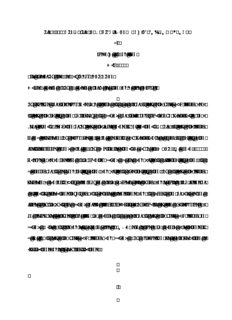
THE EFFECTS OF THERAPEUTIC HORSEBACK RIDING ON BALANCE by Susan Keel Anderson PDF
Preview THE EFFECTS OF THERAPEUTIC HORSEBACK RIDING ON BALANCE by Susan Keel Anderson
THE EFFECTS OF THERAPEUTIC HORSEBACK RIDING ON BALANCE by Susan Keel Anderson May 2014 Director of Thesis: Dr. David Loy, LRT/CTRS Major Department: The Department of Recreation and Leisure Studies The purpose of this study was to determine the effects of therapeutic horseback riding as a therapeutic intervention to improve the balance of thirty individuals who participated in a Professional Association of Therapeutic Horsemanship International (PATH) therapeutic riding member program. The study lasted ten weeks, with each participant receiving the intervention for thirty minutes, once a week. The Multi-Directional Reach Test (MDRT) (Newman, 2001) was used as an instrument to quantify balance before and after the first intervention, the beginning of the second intervention, and after the last intervention. The therapeutic riding program began with active arm movements to encourage stretching, and required two forms of external perturbations involving at least three transitions, and the completion of at least one figure eight to challenge balance of riders with disabilities. This quasi-experimental study used a one-group pretest-posttest design to examine the effects of therapeutic horseback riding on balance. Paired t-tests and repeated measures ANOVAs were used to examine a relationship between therapeutic horseback riding and balance. The discussion presents practitioner applications and research implications. THE EFFECTS OF THERAPEUTIC HORSEBACK RIDING ON BALANCE A Thesis Presented to The Faculty of the Department of Recreation and Leisure Studies East Carolina University In Partial Fulfillment of the Requirements for the Degree Master of Science in Recreational Therapy Administration by Susan Keel Anderson East Carolina University © Susan-Keel Anderson, 2014 THE EFFECTS OF THERAPEUTIC HORSEBACK RIDING ON BALANCE by Susan Keel Anderson APPROVED BY: DIRECTOR OF THESIS: _______________________________________________ David P. Loy, Ph.D., LRT/CTRS COMMITTEE MEMBER: ________________________________________________ Megan Janke, Ph.D., LRT/CTRS COMMITTEE MEMBER: ________________________________________________ Clifton Watts, Ph.D. COMMITTEE MEMBER: ________________________________________________ Amy Gross McMillan, Ph.D., PT COMMITTEE MEMBER: ________________________________________________ Linda Moran, PT CHAIR OF THE DEPARTMENT OF RECREATION AND LEISURE STUDIES: ________________________________________________ Debra Jordan, Re.D. DEAN OF THE GRADUATE SCHOOL: _________________________________________________ Paul J. Gemperline, Ph.D. ACKNOWLEDGEMENTS Thank you to everyone who supported me along the way of this endeavor, I couldn’t have done it without you all! A special thanks to my parents and my thesis mentor. TABLE OF CONTENTS SECTION I: MANUSCRIPT Introduction ........................................................................................................................... 1 Children and Adults with Disabling Conditions ............................................................... 1 Balance ............................................................................................................................ 2 Therapeutic Horseback Riding & Balance ....................................................................... 5 Methods ................................................................................................................................. 6 Research Questions ........................................................................................................... 6 Participants ....................................................................................................................... 6 Research Design ............................................................................................................... 7 Setting ............................................................................................................................... 7 Independent Variable ........................................................................................................ 8 Dependent Variable .......................................................................................................... 9 Procedure ....................................................................................................................... 10 Data Analysis ................................................................................................................. 12 Results ................................................................................................................................. 12 Daily Session Effects of THR on Balance (RQ1) .......................................................... 14 Comprehensive Balance Changes Post 10-Week Intervention (RQ2) ........................... 16 Programmatic Carry-Over Balance Effects Post Intervention (RQ3) ............................ 18 Discussion ............................................................................................................................ 21 Daily Session Effects of THR on Balance (RQ1) .......................................................... 21 Comprehensive Balance Changes Post 10-Week Intervention (RQ2) ........................... 22 Programmatic Carry-Over Balance Effects Post Intervention (RQ3) ............................ 23 Conclusion ........................................................................................................................... 25 Limitations ...................................................................................................................... 25 Future Research .............................................................................................................. 27 Section I References ........................................................................................................... 29 SECTION II: EXTENDED LITERATURE REVIEW Animal Assisted Therapy .................................................................................................... 35 Horse Therapy ..................................................................................................................... 36 Children and Adults with Disabling Conditions ................................................................. 41 Theoretical Frameworks ...................................................................................................... 42 Functional Determinants of Balance ................................................................................... 46 Therapeutic Horseback Riding and Balance ...................................................................... 49 Summary ............................................................................................................................ 51 SECTION III: EXTENDED DISCUSSION Daily Session Effects of THR on Balance (RQ1) ............................................................... 53 Comprehensive Balance Changes Post 10-Week Intervention (RQ2) ................................ 61 Programmatic Carry-Over Balance Effects Post Intervention (RQ3) ................................. 68 Conclusion ........................................................................................................................... 79 Limitations ........................................................................................................................... 80 Future Research ................................................................................................................... 82 APPENDIX A: IRB Approval Form ............................................................................................. 85 APPENDIX B: Agency Letter of Permission ............................................................................... 86 APPENDIX C: Study Cover Letter .............................................................................................. 87 APPENDIX D: Adult Informed Consent ..................................................................................... 88 APPENDIX E: Parental Assent .................................................................................................... 92 APPENDIX F: Assent .................................................................................................................. 96 APPENDIX G: Correlation Table: Number of Years Riding & Balance Change ........................ 99 APPENDIX H: Full References .................................................................................................. 100 SECTION I: MANUSCRIPT Introduction Children and Adults with Disabling Conditions Approximately 54 million people in the United States are living with a disabling condition, which equates to one in every five people (US Department of Health and Human Services, 2013). Disabilities can be caused by birth, an accident, or age (US Department of Health and Human Services, 2013). Physical inactivity is a common problem among individuals with a disabling condition (Shih, Chen, & Shih, 2012) and increases the risk for limitations and secondary health issues (Rimmer, 2007). Rimmer (2007) suggested that physical activity is low for individuals with disabilities as a direct result of their disabling condition and the barriers presented by the environment. Furthermore, Rimmer, Riley, Wahg, Rauworth, and Jurkowski (2004) suggested that access to physical activities remains a limiting barrier among individuals with disabilities. More importantly, individuals with disabilities may lose function as a result of inactivity (Rimmer, 2007) and this may ultimately decrease independence (Shih, Chen, & Shih, 2012) and balance abilities (Silkwood-Sherer, 2012). Impaired balance can often lead to greater physical disability, and problems with activities of daily living (Edgren et al., 2013). Balance is equally an issue among individuals in wheelchairs who are unable to perform activities that are pertinent to their everyday lives without the ability to achieve sitting balance (Petrofsky, 2006). Balance affects an individual’s task performance and mobility as it is involved in all levels of tasks that humans engage in from infancy to adulthood. While partaking in tasks, humans are presented with balance challenges. Balance challenges are activities that cause the balance system to work. To improve the success rate of
Description: